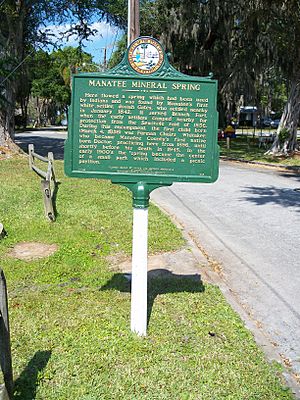Manatee Mineral Springs Park facts for kids
Quick facts for kids Manatee Mineral Springs Park |
|
|---|---|
| Indian Springs Park | |

Historical marker located in the park
|
|
| Lua error in Module:Location_map at line 420: attempt to index field 'wikibase' (a nil value). | |
| Location | Bradenton, Florida |
| Area | 1.96 acres (0.0079 km2) |
| Created | January 1842 |
| Operated by | City of Bradenton |
| Open | Year round |
Manatee Mineral Springs Park, once called Indian Springs Park, is a cool neighborhood park in Bradenton, Florida. It's named after a special natural spring found right there. This park is one of the oldest in the area. It will also be an entrance to the new part of Bradenton's Riverwalk. It's a park for everyone, created with help from both the city and private groups.
Contents
Park History
For hundreds of years, people have used the spring's water. Travelers, hunters, and early settlers near the Manatee River all drank from it.
A Place of Freedom
In 2018, the park became part of the Underground Railroad Network to Freedom. This means it was a safe place for people escaping slavery. Between the late 1700s and 1821, many people seeking freedom lived near this spring. They had escaped slavery from a community called Angola. When Angola was attacked in 1821, some people found safety deeper in Florida or in the Bahamas.
Park Features and Discoveries
Today, the park has picnic tables and a small gazebo. Special signs tell the stories of all the different people who have used the spring. These include Native Americans from long ago, Spanish explorers, the freedom seekers from Angola, and even soldiers from the Third Seminole War and the Civil War. The park is next to the Curry Houses Historic District. In 2020, digging at the park found clues about these past times.
Early Settlers and Natural Wonders
A Florida State Historical Marker at the park tells about the first European-American settlers in Manatee. Three Spanish fishermen led Josiah Gates, the first white settler, to this spot in late 1841. In 1842, Henry and Ellen Clark bought the spring property. They built the town's very first trading post there.
In 2006, the park's natural spring was named a "Florida Natural Spring" by the Florida Geological Survey. A huge black bead tree growing by the spring was added to the National Register of Big Trees in 2007.


